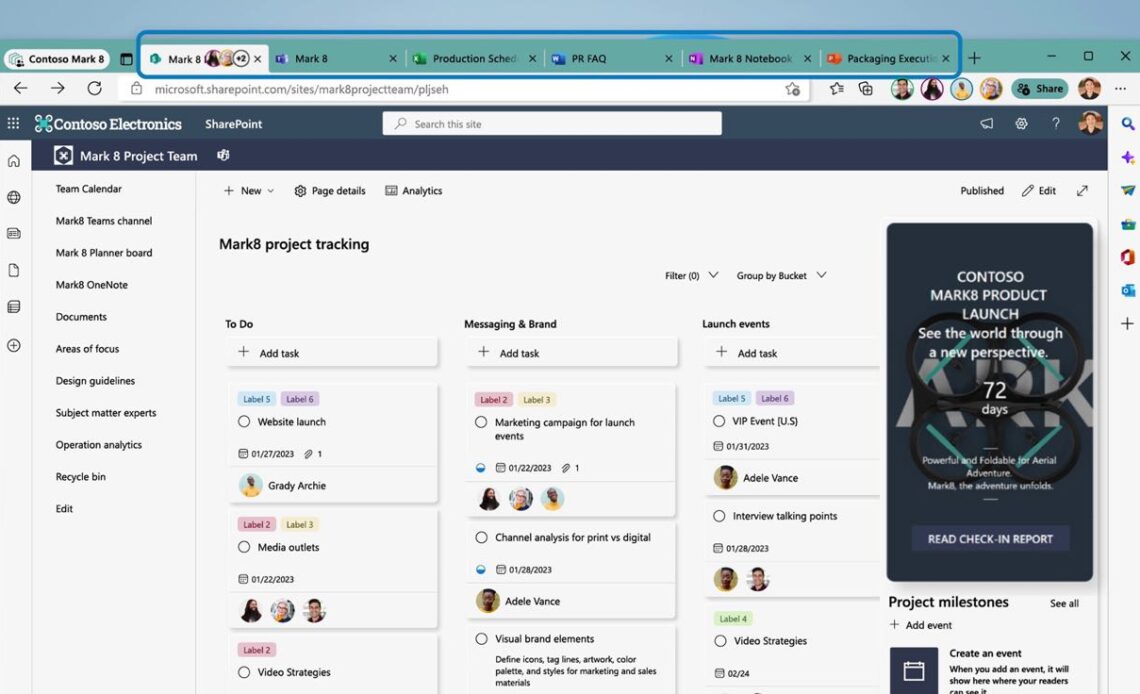
Microsoft Ignite announced services and updates designed to help customers, partners and developers get the full value of Microsoft’s technologies. At every layer of the tech stack, whether it’s infrastructure, data, hybrid work, developer tools and security, the Microsoft Cloud showcased solutions to help organizations be more secure, and to help their workers complete their tasks more easily and effectively.
Microsoft knows that things become most useful to businesses when they become part of ordinary workflows, which is why the company made huge investments in overall AI technology, Microsoft 365, developer tools, Microsoft Cloud and in security offerings.
“At this year’s Ignite we are focused on how Microsoft Cloud is helping customers do more with less. In today’s uncertain economic environment, companies are looking to change the way they do work to get better results, with less friction and more choice,” said Frank X. Shaw, Corporate Vice President, Communications.
Take a look at what’s next for Microsoft and its partners, technical decision-makers and information technology implementers.
Infrastructure that works for every customer
-
Microsoft Intelligent Data Platform, introduced earlier this year, set out to unify Microsoft’s database, analytics and data governance offerings so customers didn’t have to. That platform is now expanding, with 12 partners joining the ecosystem.
-
Azure Cosmos DB already helps mission-critical applications of any size or scale deliver speed and availability to users anywhere in the world, increasing geographic availability, scalability and distribution. Now, Microsoft is adding distributed database support for PostgreSQL, a popular open-source database engine. This means PostgreSQL developers can take advantage of the speed, scale and performance of Azure Cosmos DB, and open-source developers can access both structured and unstructured data in one familiar database service.
-
Azure Kubernetes Service on–premises or at the edge with Azure Arc., enables customers to take advantage of the capabilities of Azure wherever they are. Microsoft is also continuing to invest in the infrastructure that carries it all, with Azure public multi-access edge compute available today.
-
Visual Studio images for Microsoft Dev Box, a service in preview that provides developers with cloud-based, ready-to-code workstations. With Visual Studio available, as soon as a developer creates a dev box they can save time and focus on coding what matters.
Harnessing the power of AI
-
Azure OpenAI Service, part of the Azure AI platform, will offer invite-only access to DALL·E 2, a model that allows users to generate custom images using text or images. The addition of the DALL·E 2 model expands the breadth-of-use cases Azure OpenAI Service customers can employ with the security, compliance, and responsible AI guardrails that Azure provides. Select customers will be able to generate content, images, and code to bring visual ideas to life – all from inputting simple text.
-
Power Automate, simplifies workflows using the power of AI in everyday natural language. Users can create a cloud flow that corresponds to the request made using natural language. Here, AI helps to turn low code into no-code, making it easier for more people to build different types of automation faster.
-
Microsoft Syntex integrates offerings from across the Microsoft Cloud, from Microsoft 365 and Azure to Power Platform and Microsoft Purview. Syntex automatically reads, tags and indexes high volumes of content and connects it where it’s needed in context – in search, in applications and as reusable knowledge.
-
Microsoft Intelligent Document Processing, powered by AI Builder and Power Automate, enables end-to-end document processing with no code required, while AI Builder automates this process, giving workers time back to focus on more high-priority work.
-
Microsoft is also making conversation intelligence free for Dynamics 365 Sales Enterprise and the newly released Viva Sales. The solution gives sellers the power of insights while helping them be more productive by using analytics and data science.
Helping organizations thrive in the new world of work
-
Microsoft Places, a new workplace app, optimizes the use of physical space. According to Microsoft’s recent Work Trend Index, more than 80% of employees go into the office for each other. Places provides insights into when colleagues are coming into the office or what meetings are best suited for in person.
-
Intelligent recap, will use AI to assign tasks from meetings, automatically generate chapters from the meeting and share personalized insights from the recording, enabling users to discover information that matters most to them. It will be, along with other new features, delivered as part of the new Teams Premium add-on, purchased separately.
-
Microsoft Edge Workspaces, a shared set of browser tabs where groups can view the same websites and latest working files in one place. As the team works together, tabs are updated in real time, so everyone stays on the same page.
Comprehensive security means helping protect everyone wherever they choose to work
-
Defender for DevOps, allows organizations to secure applications as they are being built, giving developers the assurance that when they get code from external sources or are working with large application teams, they know they can get ahead of security vulnerabilities and deliver a more secure solution.
-
Power Platform Managed Environments, enables organizations to introduce low code broadly to spur innovation with the knowledge that IT admins maintain governance and security capabilities over low-code implementations, allowing teams to create at scale without security concerns.
-
Microsoft Entra, introduces identity and access management solutions designed to securely work across multiple cloud platforms. Microsoft Entra Identity Governance helps organizations ensure the right people have the right access to the right resources at the right time. Within Entra Identity, Workload Identities controls and secures identities for digital workloads, such as apps and services, and controls user access to cloud resources, while certificate-based authentication enables customers to adopt easily deployable phishing-resistant authentication.

